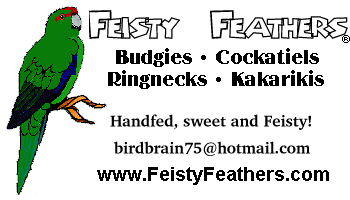Bird Jargon
Are you new to the bird world? When you talk to aviculturists are you clueless as to what they are talking about? Do you not even know what an aviculturist is? Then this section is for you! Find out what some common terms mean. Please e-mail me if I missed a word.

- Aspergillosis
- A specific fungal infection. The spores can be found everywhere but birds are more likely to get sick when stressed.
- Albino
- A bird that has no pigment. They usually appear white with a red eye.
- Aviary
- A place where birds are kept. It can refer to a single cage or flight, or to an entire business.
- Aviculturist
- Someone who specializes in the care and breeding of captive birds.
- Captive Bred
- A bird that was hatched and raised in captivity. It is now illegal to import birds so most of the ones you find today will be captive bred.
- Cere
- The fleshy section of skin around the nostrils.
- Cinnamon
- A mutation that mutes or dilutes the colors in a bird.
- Clipped wings
- When a birds primaries are cut to keep the bird from flying. It is not permanent and does not injure the bird. However, I would not advise using this on non-psittacine birds such as finches and canaries because they do not use their beaks to climb.
- Crop
- Kind of like a stomach. It serves as a holding tank for food before it passes into the gizzard and gets digested. It is located between the lower neck and the upper chest.
- Crown
- The feathers just above the cere. Like the forehead.
- Cuttlebone
- The remains of a cuttlefish. It adds calcium to a bird's diet.
- Dimorphic
- You can tell by sight the difference between the sexes of a species (budgie males have a blue cere and females have a brown one).
- DNA sexing
- A blood sample is taken from a clipped nail and the DNA is analyzed to find out what sex a bird is.
- Eye ring
- When there is fleshy skin surrounding the eye.
- Flight
- A large cage that is long enough to allow ample space for flying. Highly recommened when housing Aussies.
- Fostering
- When chicks or eggs from one nest are placed under the care of different parents.
- Handfed
- A chick that was raised by a human instead its parents.
- Handtame
- A bird that is tame. It could have been handfed or just taught well from an (usually) early age.
- Hybrid
- An animal that is a cross between two species. Not advised.
- Keel
- The sternum flattens out to provide a place for flight muscles to attach. This part of the bone is easily broken or bruised.
- Lutino
- A mutation in which the darker pigment is absent. Birds usually appear yellow with red eyes.
- Murphey's Law
- Anything that can go wrong will, and at the worst possible moment. Live by this law.
- Mutation
- A slight abnormality in the genes of a bird. It can produce cool colors and patterns. Rare mutations are highly prized and expensive.
- Nape
- The back of the neck.
- Nestbox
- A box or cavity in which captive birds will raise their young.
- Pellets
- A formulated diet which should provide all the neccessary vitamins and minerals for a bird.
- Pied
- Alternating patches of normal and unpigmented feathers. Very attractive.
- Primaries
- The flight feathers. Located on the outermost part of the wing.
- Psittacine
- A parrot or parakeet.
- Regurgitate
- Pairs will often feed each other to bond better. Chicks are fed food like this.
- Splayed (spraddle) legs
- When a chick's legs do the splits. It can be caused by malnutrition, poor genes, slipper floor, mother sitting on it too hard, etc.


Go Back
© 1998 birdbrain75@hotmail.com





